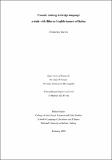| dc.contributor.advisor | O'Connor, Anne | |
| dc.contributor.advisor | McLoughlin, Laura | |
| dc.contributor.author | Nicora, Francesca | |
| dc.date.accessioned | 2020-02-28T14:15:39Z | |
| dc.date.issued | 2020-02-28 | |
| dc.identifier.uri | http://hdl.handle.net/10379/15819 | |
| dc.description.abstract | Mastering prosodic features is deemed as one of the most important objectives in language learning. The Council of Europe has recently published the New Companion Volume to the Common European Framework of Reference for Languages that promotes the acquisition of prosodic structure in a L2. However, researchers have not yet reached a consensus on how prosody can be effectively taught, and there is still a need to fully understand if and how L2 learners develop phonological competence. This is particularly evident when considering the limited literature devoted to studies on Italian-L2 prosodic training. On the other hand, studies based on a contrastive phonological analysis have proved that the investigation of differences and similarities across languages is crucial in the teaching of prosody, for the establishment of intonation models, for the formulation of hypotheses on the process of L2 acquisition, and for the identification of the difficulties learners may encounter in language learning.
This research project stems from a cross-linguistic comparison of the two phonological systems of the L1 of the learners (Galway Hiberno-English) and the target language (La Spezia Italian, the mother tongue of the teacher) and aims to investigate the effectiveness of explicit prosodic training embedded in a didactic environment, looking specifically at lexical stress position and intonation patterns in L2 speech production. The Autosegmental-Metrical (AM) theory and the Tone and Break Indices (ToBI) system, used to prosodically describe a wide range of languages and varieties, underpin the present study. Data analysis has yielded experimental evidence that promotes the teachability of prosody, shows how learners improved phonological proficiency thus demonstrating the potential of the research design. This thesis may be considered a crucial step in the field of L2 prosody, while also offering a first insight into the prosodic features of the abovementioned varieties and providing a pioneering overview of L2-Italian intonational deviations. | en_IE |
| dc.publisher | NUI Galway | |
| dc.rights | Attribution-NonCommercial-NoDerivs 3.0 Ireland | |
| dc.rights.uri | https://creativecommons.org/licenses/by-nc-nd/3.0/ie/ | |
| dc.subject | speech prosody | en_IE |
| dc.subject | didactics | en_IE |
| dc.subject | prosodic competence | en_IE |
| dc.subject | phonology competence | en_IE |
| dc.subject | prosodic training | en_IE |
| dc.subject | Autosegmental Metrical approach | en_IE |
| dc.subject | computer assisted pronunciation training | en_IE |
| dc.subject | computer assisted language learning | en_IE |
| dc.subject | Italian as foreign language | en_IE |
| dc.subject | teaching Italian | en_IE |
| dc.subject | Italian | en_IE |
| dc.subject | Arts, Social Sciences and Celtic Studies | en_IE |
| dc.title | Prosodic training in foreign language: a study with Hiberno-English learners of Italian | en_IE |
| dc.type | Thesis | en |
| dc.description.embargo | 2025-02-25 | |
| dc.local.final | Yes | en_IE |
| nui.item.downloads | 0 | |


